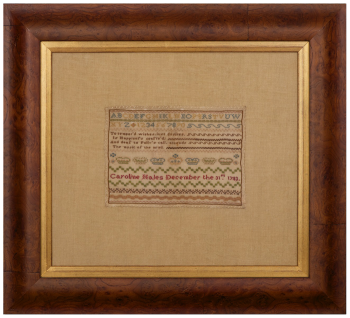
Samplers

The history of Samplers is a subject in its own right, the following is a short summary.
The term ‘Sampler’ is believed to be derived from the French essamplaire meaning ‘an example to be followed’. Samplers have changed significantly since the 16th century both in design and function from an example of an embroider’s expertise to an education tool for schoolchildren. It is thought that early samplers served both as a memorandum and an example of numerous designs, comprising different stitches and embroidery techniques.
Samplers exist in two forms; band samplers which comprise an orderly arrangement of patterns and/or motifs and occasionally cut or pulled thread work; and spot samplers, randomly placed motifs often in silk and intended to be appliquéd onto household furnishings.
The earliest record of a sampler was in the household accounts of Elizabeth of York, the wife of Henry VII in 1502 and the earliest surviving dated English sampler was made by Jane Bostock in 1598 thought to celebrate the birth of her daughter (or possibly niece) Alice Lee and housed at the V&A.
It was not until the mid-eighteenth century that young girls began to work samplers either at home under the supervision of an embroidery teacher and/or in schools as part of their education. In the 19th century most samplers were sewn in schools and towards the end of the century the design had changed from the embroidered sampler to one that described the embroiders’ skills. This continued into the 20th century until the introduction of the more affordable sewing machine resulted the teaching of such skills dying out.
